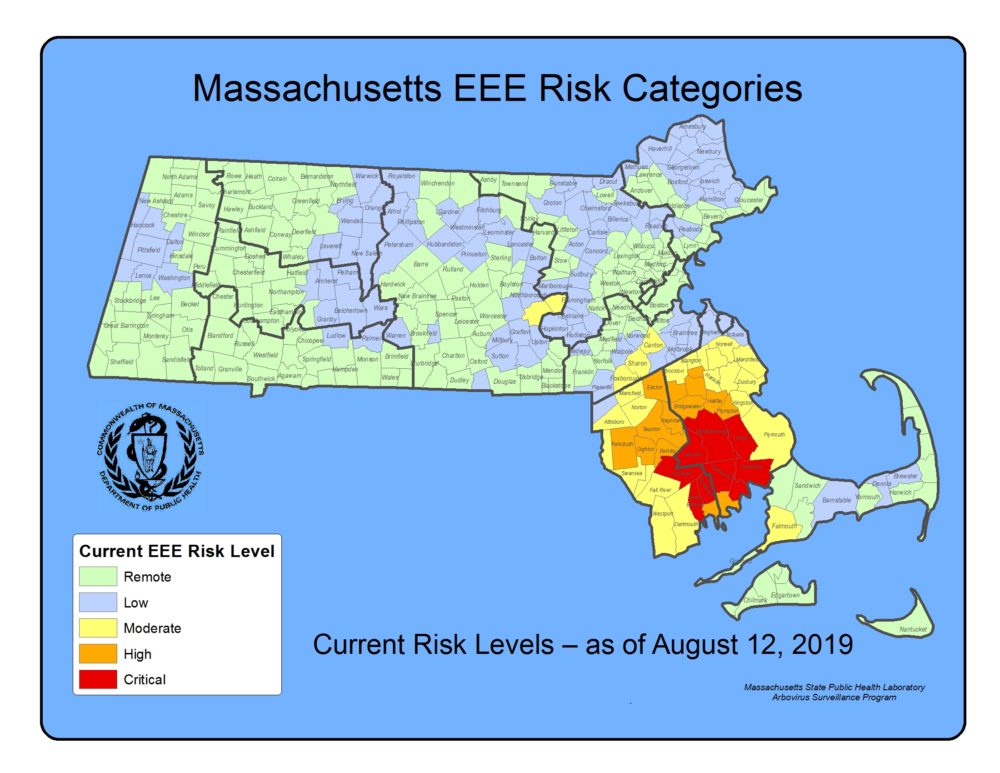Advertisement
Is Your Town At Critical Or High Risk For EEE? Here's How The State Determines Risk Level
Update 9/6/2019: The state Department of Public Health has confirmed two new human cases of Eastern equine encephalitis (EEE) in Massachusetts, bringing the total this year to seven. A fifth case was announced on Sept. 5. There have also been eight cases in horses and one in a goat.
Our earlier post:
Massachusetts has been conducting aerial spraying of insecticides in areas of eastern Worcester County and western Middlesex County this week, because of elevated risk of mosquito-borne Eastern equine encephalitis, or EEE.
Officials ordered the spraying in response to the state raising the risk level for EEE in those areas. Parts of Bristol and Plymouth counties were sprayed earlier in August and again over the last week.
Eastern equine encephalitis is a dangerous virus that attacks the central nervous system. It's fatal in about 40% of cases and can cause permanent neurological damage in those who survive.
The state Department of Public Health has declared a critical risk for EEE for any part of the state where human cases have taken place or a veterinary animal, such as a goat or horse, has tested positive. On Aug. 10, DPH announced the first human case of 2019 in southern Plymouth County. That was the first time this year communities in the state were declared to be at critical risk:

Then, less than a week later, the second human case was reported — in a Grafton man between the ages of 19 and 30 years old. Since then, two more Massachusetts residents have tested positive for EEE. In the most recent case, a woman from Fairhaven died.
We wanted to find out how the state determines a community's risk for EEE. When looking at the state's maps for EEE risk, it appears that the human cases (and a horse in Methuen that tested positive) are the driving factor in not only the community in question being declared to be at critical risk, but in surrounding communities being elevated to critical or high risk. And indeed, DPH says it uses a stepped-down risk designation moving outward from where a human or veterinary animal has contracted EEE.
But according to the state epidemiologist for DPH, Dr. Catherine Brown, there are several other factors that contribute to whether the state elevates a community's EEE risk level:
Advertisement
Mosquito Surveillance Data
"Once you get to the point where you are finding repeated evidence of EEE in mammal-biting mosquitoes from the same area for multiple weeks in row, that actually is sufficient to assess a community at 'high' risk for EEE," Brown says. "And that's then the step before we get to 'critical,' which is after there's been evidence of either a human or a veterinary case."
Historic EEE Data
"Where have we had evidence of transmission to humans or animals in the past?" is one data point, Brown says. "Where we have seen a lot of mammal-biting mosquitoes in the past?"
Mosquito-Friendly Swamp Habitat
"It's not just any old wetlands," Brown says. In southeastern Massachusetts, she says, it's large red maple and white cedar swamps that are "the driver of EEE activity." In eastern Worcester County and western Middlesex County, it's smaller hardwood swamps.
And this year, Brown explains, positive tests for EEE in mammal-biting mosquito samples have been isolated to the areas around where the human and animal cases have taken place. So in all of the areas you see in blue on the state's maps, no tested mosquitoes have turned up positive for EEE.

"It really is that the test results that we're getting — mosquito, animal and human — are really indicating these sort of pockets of activity," Brown says. "EEE has always shown up in pockets, based on the type of habitat that really supports the EEE activity. It's not something that we have seen pose a uniform risk across the state. And so the map that you see today accurately reflects the combination of the data from mosquitoes, animals, humans, habitat and historic information that we believe most accurately reflects the risk that exists today."
Public health leaders say people in every community of the state should take precautions against mosquitoes, however, because the insects of course travel and not every community has mosquitoes tested. They urge residents to use mosquito repellent. And in the communities at elevated risk, especially, they say people should avoid outdoor activities between dusk and dawn.
This article was originally published on August 28, 2019.
